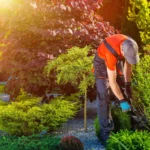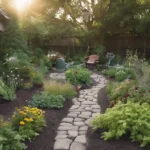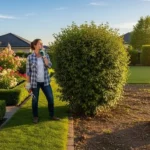Bush & Tree Trimming vs. Removal Explained
Unsure between trimming vs. removal? Learn how to decide what’s best for your property to boost curb appeal, safety, and long-term landscape health.
Are you looking for a way to keep your landscape healthy and protect your home with smart long-term garden care decisions at the same time? This guide can help you accomplish that in no time! With overgrown plants and trees, most property owners face the same dilemma – trim or remove?
This guide breaks down brush and tree trimming removal in a beginner-friendly manner, allowing you to make a confident decision. Let’s get into it.
What You Choose Matters – Pruning vs. Removal
Making a correct decision between pruning vs removal affects:
- Safety: Weak branches and compromised trunks can fail without warning.
- Plant health: Cutting extends plants’ life, whereas neglecting them speeds declines.
- Property Value: A well-kept canopy increases curb appeal; hazards do the opposite
- Budget: Pruning strategically often costs less now and saves more later; however, delaying removals multiplies costs and risks.
Trimming (Pruning): What It Is and How It Works
Pruning targets selected branches or stems and removes them to improve plant structure, health, and appearance. It’s more than just “cutting” – it’s surgical.
Benefits of Pruning:
- Health: Removes dead or diseased plants, reduces fungal pressure.
- Structure: Develops strong branch architecture to withstand storms.
- Appearance: Shapes for symmetry and clearances.
- Performance: Stimulates new growth so plants bloom better.
- Prevention: Early corrective cuts reduce future failures and expensive fixes
When Trimming is Needed
- Minor defects or overgrowth.
- Branches touching roofs, fences, sheds, or vehicles
- Reducing sails before stormy seasons.
- Opening views to windows, cameras, or streetlights.
- Structure pruning in the first 5 – 10 years sets a lifetime of stability.
Trimming Do’s and Don’ts
- Do maintain a 2 – 3 inch collar around branch bases, cut just outside the branch bark ridge so trees can seal wounds.
- Do prune during the right season for your species. (Late winter for most or after bloom for spring flowering shrubs)
- Do disinfect tools between cuts when disease is suspected.
- Don’t top trees, as it can trigger weak water sprout growth and long-term stability.
- Don’t leave long stubs or make flush cuts, as both can harm natural healing.
Removal: What It Solves That Pruning Can’t
Removal is the complete “removal” of a tree or brush to stump level. It’s decisive and sometimes the only safe choice.
Signs It’s Time for Complete Removal:
- Dead or dying trees /shrubs with progressive decline.
- Structural failure risks such as large cracks, leaning with heaving soil, hollowing, major root damage, or repeated root damage.
- Irreversible Disease/institution in case treatment success is low or cost-prohibited.
- Choking out invasive species spreading aggressively.
- Persistent gutter clogging, blocked solar panels, or a line of sight.
When to Remove Trees or Brushes
- The brush is dominating, blocking access, or harbouring pests like snakes or rodents.
- The thicket is a fire hazard or regularly obstructs drainage and sightlines.
- The species is thorny/invasive and outcompetes desired plants.
How to Cut Trees Safely
Cutting trees is among the most hazardous trades. Homeowners often underestimate how much work and force are typically involved in cutting trees safely.
Here are a few things to consider:
- Stay off ladders with chainsaws, as this is how most accidents start.
- Assume tension and compression in every branch. Wood can snap.
- Beware of kickback zones on chainsaw bars.
- Be mindful of utilities. Overhead and underground lines are no-go zones without proper clearance requests.
- Use proper gear like a helmet, eye/ear protection. Chainsaw chaps, gloves, and boots.
- Understand when to stop. If the cut is above shoulder height, near structures, or requires rigging, this is when to call a pro.
Pro Tip: Even routine pruning near roofs or fences requires ropes, friction devices, and controlled lowering.
Cost & Timing: What You Can Expect
- Trimming Cost: Can vary by tree size, species, and scope.
- Removal Costs: Can rise with hazards, limited access, proximity to structures, required rigging, crane work, and stump grinding.
- Ideal Time: Often falls in dormant seasons for many species. Flowering shrubs may need post-bloom timing to preserve next year’s flowers.
Environmental & Aesthetic Considerations
- Wildlife Value: Some trees provide nesting cavities, food, and shade. It is better to consider selective pruning or phase removal to prevent harm to the habitat.
- Sahde and Cooling: A Mature canopy reduces heat and AC bills. Consider small structural prunes over full removal.
- Replacement Plan: If removal is necessary, plant the right tree, right place, to keep appropriately sized species away from wires, foundation, or driveways.
Common Mistakes to Avoid
- Topping trees: to control size can lead to decay, pests, or future failures.
- Overthinning: Can lead to whipsawing and broken limbs.
- Ignoring Root Zones: Parking, trenching, or heavy mulching against the trunk can stress trees.
- Cutting At The wrong time: This can affect bloom, sap flow, and disease pressure.
- Skipping Cleanup: Leftover bush piles can harbor pests and are a fire hazard.
More Tips: Shrub and Tree Clearing: Best Practices to Prevent Regrowth and Protect Your Landscape
Short Answer
Prune When: The plant is healthy, the structure is sound, growth is walkways, storm prep is required, or if you want to improve shape, flowering, or airflow.
Remove When: The tree or brush is dead/dying or deceased beyond recovery, structurally unsafe, damaging foundation or utility lines, invasive, or restricting light/space you need.
More Services: A Complete Guide to Tree and Bush Removal for a Cleaner, Healthier Yard
Special Notes on Brush Management
A dense brush can be your and your landscape’s biggest hidden liability. Here is when to remove brushes entirely vs cut back:
- Cut back if native or preferred plants are simply overgrown, and you want layered habitats with paths and sightlines.
- Full removal is brush is invasive, thorny, or harbors pests, blocks maintenance access, or regrows into driveways/sidewalks.
- After removal, stump treat or grind to deter resprouts, then re-mulch and replant to prevent the vacant soil from becoming a weed magnet.
FAQs – Overgrown Trees & Bushes
Is pruning vs removal a one-time decision?
No, because landscapes evolve. A tree pruned today might need structural pruning in a few years or removal if decline begins.
How often is pruning required?
Many trees benefit from light maintenance every 2-5 years.
Do I need a permit to remove a tree?
Yes, many municipalities require permits for trees above a certain diameter or within setbacks. At Eye Candy Lawncare, we handle the paperwork for you.
Professional Help Done Right
Ready to cut through the uncertainty? Ay Eye Candy Lawncare makes it easy to decide between and Bush and Tree Trimming vs. Removal with certified assessments, precision pruning, and safe, efficient removals.
- Our Services: Brush clearing, tree trimming, hazard takedowns, stump grinding, and seasonal care plans.
- Safety: Full PPE, insured crews, utility-aware operations, and meticulous cleanup.
- Sustainability: Right tree at the right place guidance and replacing options.
Get a free site evaluation and a clear written plan – so you know when to remove and when to prune.
Let’s decide together – trim where it helps, remove where it’s right, and leave your property stronger, safer, and better looking than ever!



